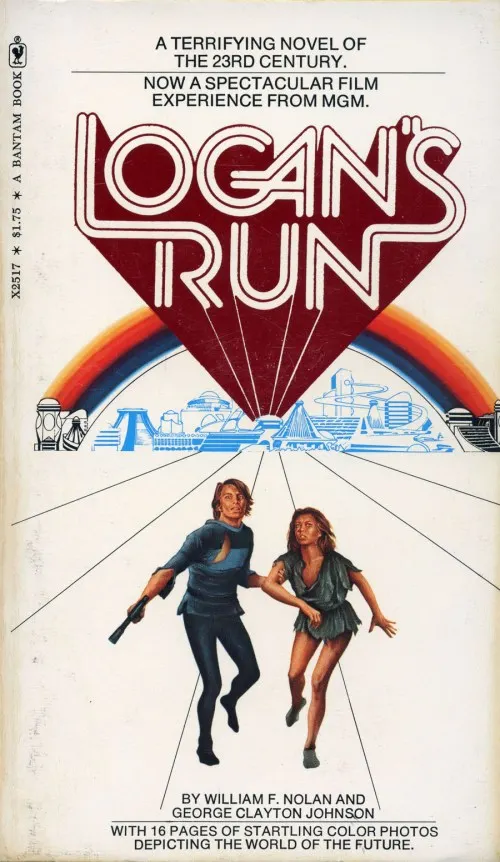For a film that opens with a crystal-embedded palm lighting up to announce your 30th birthday/death sentence, Logan’s Run surprisingly slipped into sci-fi history’s dusty corners. Sure, many genre fans remember the psychedelic sets, the chilling concept of population control through mandatory euthanasia, and that sweet, synth-heavy Jerry Goldsmith score. But Logan’s Run—both the 1976 movie and the short-lived 1977 TV series—holds more secrets than a Sandman’s database. Logen’s Run is truly a unique piece in the sci-fi genre.
Let’s go beyond the blinking Life Clocks and the giant robot that freezes people like TV dinners. Here’s what even the diehards might’ve missed.
⸻
The Logan’s Run Novel Is Very Different—and Way Darker
First things first: the Logan’s Run movie was adapted (loosely) from the 1967 novel by William F. Nolan and George Clayton Johnson. But the film has changed a lot—and we’re not just talking about fashion. For starters, the book’s age limit is 21, not 30. You got three decades in the movie—luxury!
Even more striking? The world of the novel is far more expansive and chaotic. Civilization has fully collapsed, and humanity lives in domed cities and tribal wastelands, not just one self-contained plastic utopia. There’s also no central computer in the book. Instead, a more anarchic global system uses “Sleepmen” (not Sandmen) to hunt down Runners.
And instead of “Carousel,” the book has a straightforward execution chamber called the “Sleepshop.” It is less theatrical and more horrifying.
⸻
Carousel Was Almost VERY Different
Speaking of Carousel—that gloriously weird death ritual where citizens float up in hopes of “renewal” (aka explode mid-air)—the sequence almost looked completely different.
In early drafts, Carousel was a more subdued clinical process: a mass cremation in a public chamber. But the film’s production designer, Dale Hennesy, pushed for something more surreal. The end result was a bizarre blend of Cirque du Soleil and cult propaganda, with floating victims, masks, and thunderous applause. It’s deeply unsettling… and that’s the point.
Also, the original idea for Logan’s Run had the Sandmen escort people to Carousel, not just chase down Runners. It was more like a twisted graduation ceremony.
⸻
Box the Robot Was Supposed to Be a Cyborg… and Played by a Pop Star
Remember Box? The silver, vaguely tragic robot who freeze-dries Runners for future consumption? In the film, he’s played by Roscoe Lee Browne, and he’s one of the most unsettling one-off characters in ’70s sci-fi.
But here’s the weird part: Box was originally envisioned as a malfunctioning cyborg, with visible human parts rotting under a robotic shell. Even weirder? Producers once considered casting none other than Mick Jagger in the role. Yes, that Mick Jagger.
Imagine a skeletal Jagger in a robot suit talking about “fish, and plankton, and sea greens.”
Missed opportunity? Absolutely.
⸻
The Logan’s Run TV Series Expanded the Lore… and Got Real Weird, Real Fast
After the success of the movie Logna’s Run, MGM launched a Logan’s Run TV series in 1977, starring Gregory Harrison as Logan and Heather Menzies as Jessica. On paper, it should’ve worked. The sets were still futuristic (if a bit shinier), and the show gave Logan and Jessica a robot sidekick named REM (played by Donald Moffat, chewing scenery like a champ).
But ratings tanked, and the series only lasted 14 episodes.
That said, the show did offer some wild additions to the lore:
• The Computer is Sentient: The ruling AI of the city becomes an actual antagonist, not just a backdrop. It even sends new Sandmen after Logan and Jessica.
• Time Travel (Sort of): One episode involves a society stuck in a constant reenactment of the American Revolution. It’s very “Planet of the Apes with costumes.”
• Alien Interference: One rejected script (never filmed) suggested that the domed cities were originally created by aliens who had “abandoned” Earth.
The show leans into that Star Trek energy, with a new dystopian society or ethical quandary each week. It’s campy, but ambitious.
⸻
The Original Sandman Was Almost James Caan
Before Michael York was cast as Logan, MGM wanted James Caan to lead the movie. But Caan turned it down, reportedly unimpressed with the script. This led to Michael York, who brought a more boyish, uncertain energy to the role—arguably a better fit for a character questioning his entire purpose.
Still, imagine the grizzled, cynical energy of James Caan blasting Runners with 1970s swagger. Different movie entirely.
⸻
The “Sanctuary” Ending Has Layers
In both the film and the TV series, “Sanctuary” is a lie—there’s no utopia waiting for Runners, just the ruins of the old world. But here’s the kicker: in the novel, Sanctuary does exist. It’s in space.
Logan ends up on Mars.
That twist alone reframes everything. The book ends with Logan helping rebuild society, suggesting the youth-dominated nightmare was a phase, not a permanent state.
⸻
Final Thought: Logan Deserves a New Run
There have been rumors of reboots for years—at one point with Ryan Gosling, then Nicholas Winding Refn, then Simon Kinberg. None materialized.
But maybe that’s okay. Logan’s Run is a perfectly imperfect slice of ‘70s sci-fi, wrapped in shag carpet futurism and sprinkled with disco nihilism. The forgotten lore makes it even richer for those willing to dig.
So dust off your palm crystal, rewatch the flick, and—if you’re brave—track down the TV show. Just don’t trust anyone over 30.
⸻
What did we miss? Got a favorite deep cut from Logan’s Run lore? Let us know in the comments.

